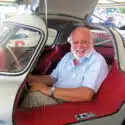Doug Nye: ‘Historic racing – every day playing with history. How can a kid get in?’
Away from the cutting edge of motor racing, Doug expected to find historic specialists struggling for recruits, but was delighted to be proved wrong
Talking with several of the Historic racing world’s leading restorers and preparers has highlighted a relatively recent concern. I was asked “How can we find good young staff for the future? Advertising has failed completely…” – then “How do you find capable kids who want to get into specialist old-style engineering like ours? Interest in our kind of cars seems to be dying”.
I have something of a vested interest here. Back in 1963 I was a racing-mad 17-year-old. I’d just won an obscure schools essay prize allowing me to choose a book as my trophy. Amid great ceremony some pompous luminary presented it to me; Nuvolari: Legendary Champion of International Auto Racing by Count Giovanni Lurani. “Well done” he said, “Here you are…” (pause – then sotto voce) “…for what good it will do you…”.
That triggered a switch in my brain. Suddenly I just had to get into that Nuvolari-style racing world (if only to prove that bore wrong). In practical terms I barely knew a torque wrench from a trolley jack, but I could communicate, and supposedly write. So within days I wrote to the racing magazines I’d studied for years, asking if they needed keen “and knowledgeable” young help? Glory be. One responded.
I took a train to an interview at Brands Hatch. In two weeks I’d abandoned school and – like a hairy ET – found myself in an entrancing new world…
Today, formally-organised major-league university courses in motor sport engineering feed graduates into contemporary Formula 1, GT and major manufacturer teams, so perhaps the need for young enthusiasm to kick down a door, or somehow to find another way ‘in’, is not so great. But what I was hearing from leading Historic-racing restorers and preparers attracting no interest from new youngsters was deeply troubling. So perhaps the big problem was that Historics inevitably spell obsolescent technology – traditional heritage craftsmanship? Yawn…
But then, speaking with arguably more precision-engineering than conventional restoration and preparation specialists… an entirely more optimistic picture emerged.
I remember looking at a heritage steam loco once with ‘Doc’ Postlethwaite of March, Hesketh and Ferrari fame. He remarked “isn’t it great these enthusiast nuts keep the old technology alive? We so nearly lost the hands-on know-how for ever…”. Transfer that to Historic motor sport – in all its forms and classes, and as long as our politicians permit it to survive – and for companies in need of fresh blood there is real hope.
“If you’re keen or adaptable enough you’re old enough”
The most attractive facet of these old technologies is of course the joy they commonly bring to enthusiasts. I hesitate to compare the romantic nostalgia of steam locos with Historic racing cars being exercised on modern sterilised race circuits, but still there is so much fun to be had for those prepping and running the cars for paying owners. Fascinating work, craft skills to be absorbed, every day playing with history…and there’s the lure of paid travel attending the races too…. So just how can an enthusiastic young kid get ‘in’?.
The now nine-year-old Heritage Skills Academy operates at three sites, two at the former RAF Bicester in Oxfordshire, the third at the Brooklands Museum in Weybridge, Surrey. A conversation with HSA’s founding director John Pitchforth began with him asking me a question: “How many apprentices in the Historics area do you think we are training?”. Blinking, I suggested “Twenty to 30?”. Wrong.
“Two hundred. Fifty have qualified in the past 18 months. We presently have 160 training. We don’t just deliver apprentice training, we have a recruitment plan which takes the load off would-be employers. Applicants may come direct to us. If a company tells us their needs we send a team to understand the precise requirements. If we have an applicant we think might suit we recommend an interview.
“Training then becomes a joint process between the company and ourselves – one week in five with us at Heritage. The results? Award winning.”
He added: “Probably 35% of our apprentices work in Historics, the others with marque specialists. Where so many firms in modern racing come and go, and there’s little job security – our heritage industry produces truly adaptable, hands-on, problem-solving engineers and craftsmen, fully capable of using all techniques both old and modern. We teach old-school mechanic skills, fabrication, welding, trimming – every area.
And he paid off with these cheering lines: “We receive fresh applications all the time. We only recommend applicants already living in an interested company’s area. If you’re keen or adaptable enough you’re old enough. The current age range of our apprentices is from 16 to 52! So anybody who says this industry is dying is wrong!”
If young readers (of any age) might be interested, take a look online at heritageskillsacademy.co.uk – it’s one way to an all-absorbing enthusiast future. Hopping the fence is within grasp.
Doug Nye is the UK’s leading motor racing historian and has been writing authoritatively about the sport since the 1960s

